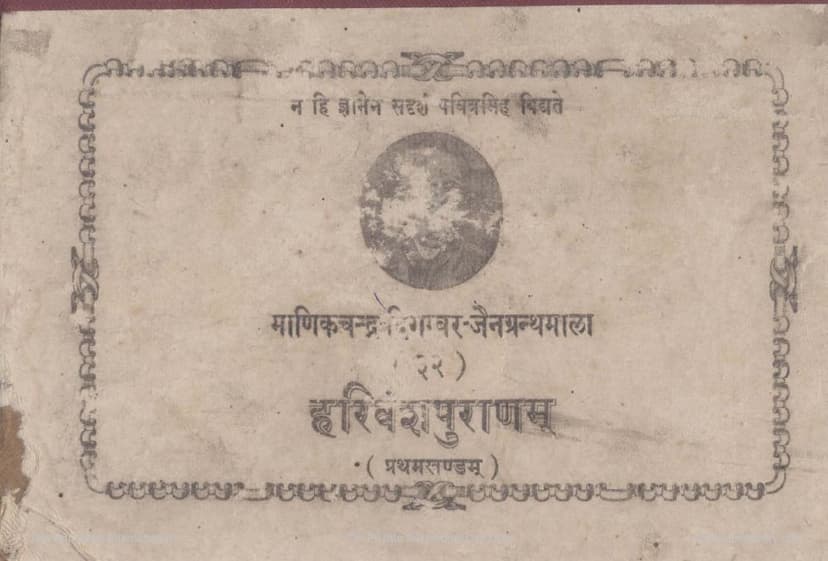Harivanshpuranam Purvarddham
Added to library: September 1, 2025

Summary
This is a comprehensive summary of the provided Jain text, "Harivanshpuranam Purvarddham" by Darbarilal Nyayatirth, based on the provided pages.
Book Title: Harivanshpuranam Purvarddham (First Part of Harivanshpuranam) Author: Darbarilal Nyayatirth Publisher: Manikchand Digambar Jain Granthamala Samiti
This text is the first part of the Harivanshpuranam, a significant and ancient work in Digambara Jain literature. It is considered the second oldest available Sanskrit work in the Prathamanuyoga (narrative tradition) of Jainism, following the Padmapurana by Acharya Ravisenacharya. The Harivanshpuranam was completed in Shaka Samvat 705 (Vikram Samvat 840).
Key Information and Themes:
- Authoritative Text: The preface highlights the importance and antiquity of the Harivanshpuranam, noting its mention of earlier works like the Padmapurana and the Adipurana.
- Completion Time and Location: The text specifies the exact year of completion and the political context of the time, mentioning the rulers of different directions. It was completed in the temple of Shantinath in Vardhamanapura, a significant city where Acharya Harishena also resided and composed his Brihat Kathakosh. The location of Vardhamanapura is believed to be in the Karnataka or Punnat region.
- Guru Parampara: The work details the author's (Acharya Jinathena's) guru lineage, tracing it back to Acharya Lohacharya. It notes a distinction in the lineage after Lohacharya compared to other Jain texts. Acharya Amitasen, a prominent scholar and ascetic, was a key figure in this lineage, and his chief disciple was Jinathena, the author of Harivanshpuranam.
- Distinction from Adipurana's Jinathena: A significant portion of the text is dedicated to clarifying that the author Jinathena of Harivanshpuranam is distinct from Acharya Jinathena, the author of Adipurana. This distinction is supported by:
- Different gurus (Kirtisena for Adipurana's Jinathena, and Jinathena for the Harivanshpuranam's Jinathena).
- Different monastic lineages (Sen Sangha/Panchastupanvay for Adipurana's Jinathena, and Punnat Sangha for Harivanshpuranam's Jinathena).
- The Harivanshpuranam's author explicitly praises Parsvabhyudaya's Jinathena and his guru Virasena in its initial verses, clearly indicating separate identities.
- Differences in poetic style, narrative techniques, and imaginative elements are noted.
- Punnat Sangha and Punnat Country: The text extensively discusses the Punnat Sangha and the Punnat country. 'Punnat' is identified with Karnataka, a region known for its abundance of Nagakesara trees. The term "Punnat" likely originated from the prevalence of these trees or possibly as a derivative of "Punnaaga." The author speculates that the Punnat Sangha might have also been called the Kittur Sangha, named after its capital.
- Sangha Divisions: The text delves into the history of monastic divisions within Jainism. It discusses the origins of various Sanghas and Ganas, citing Acharya Indranandi's Shrutavatara. It mentions the establishment of Sanghas by Acharya Arhadbali, leading to divisions like Nandisangha, Seneghha, Simghasangha, and Devaganga.
- "Jainabhasas" (Apparent Jains): The text touches upon categories of ascetics considered "Jainabhasas" (those who appear Jain but deviate from true practice), mentioning Yapaniya and Dravida Sanghas. It explains that these classifications might stem from their monastic practices, such as residing in monasteries (Chaityavasis), engaging with royal courts, managing temple properties, and not adhering strictly to the ideal of non-possession (aparigraha).
- Scriptural Content (Briefly Mentioned): The table of contents provides an overview of the sixteen chapters (Sargas) within this volume, detailing the topics covered. These include:
- Sarga 1: Introduction, mentioning earlier scholars, description of good and bad people, purpose of the text and its lineage.
- Sarga 2: Description of Videha region, King Siddhartha, Queen Priyakarini, descent and birth of Lord Mahavir (Vira), his initiation, and teachings.
- Sargas 3-8: Detailed descriptions of hells (Adholoka), the animal realm (Tiryagloka), heavens (Swaragoka), non-living substances (Ajeeva), the lineage of Kulakaras, and the avatara and life of Rishabhadeva.
- Sargas 9-16: Continuation of the life stories of Rishabhadeva, Bharat, Bahubali, and the early Harivamsa lineage, leading up to the stories of Munisuvrata and the beginning of the Harivamsa lineage.
- Sargas 17-30 (Implied): The later parts of the Purvarddha would cover the Krsna-Vasudeva and Trivikrama narratives, as indicated by the table of contents.
- Publisher's Endeavor: The preface concludes with a note about the publication effort, mentioning its history, the challenges faced due to funding, and the gratitude towards donors. It emphasizes the importance of preserving and disseminating these ancient Jain scriptures.
In essence, the Harivanshpuranam Purvarddham is presented as a crucial Jain scripture that narrates the lives of Tirthankaras, prominent figures in Jain mythology, and the history of monastic orders, while also distinguishing its author from other prominent Jain scholars of the same name. The text emphasizes the philosophical and ethical teachings within its narrative framework.